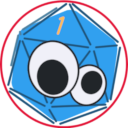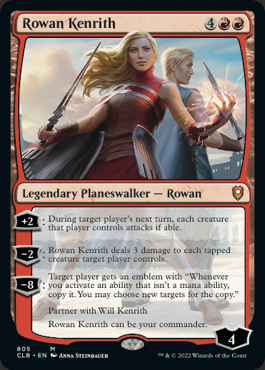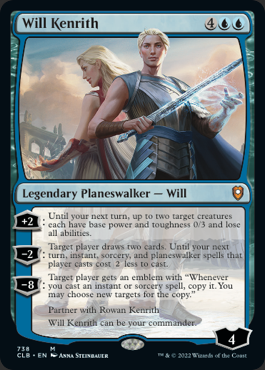Magic: The Gathering (MTG) differs from other collectible card games in its embrace of alternative rules and formats. Broadly speaking, there is only one way to play Pokemon, Yu-Gi-Oh, Lorcana, or other trading card games. The MTG community has tended to experiment more, and sometimes these community formats even gain official support. By far the most successful such format is Elder Dragon Highlander, now known as Commander.
TIME FOR BACKSTORY!
Standard Magic is a two-player format. Each player has a deck containing at least 60 cards, and up to 4 copies of any given card other than basic lands, which have no limit. Most decks will have several full playsets with 4 copies of staple cards for their deck, a few cards with 1-3 copies, and 20-24 land cards. The goal of such decks is consistency. Each player begins with 20 life, and the game usually ends when one player's life is reduced to zero through spell damage or creature attacks, although there are a several other possible ways to win or lose.
Whenever a new set is released, there is a resurgence in limited draft events. These are more chaotic. Each player gets a handful of sealed packs, which are opened one at a time. Each player chooses a card and passes the remainder to the left until all cards have been chosen, and then the cycle repeats. From these random cards, players strive to select enough for a playable deck of 40 cards with about 17 lands added and about 23 spells. This can result in no duplicate cards. Here, the strategy lies in not just playing the game, but calculating the most effective card out of a random assortment while others are competing to do the same. The current Foundations set is designed to play similarly with two packs making a 40-card deck, but without the draft process of pick-a-car-and-pass.
Back in the early days of Magic, some players decided to forego standard deck construction in favor of "Highlander" decks. These are named after the 1986 film Highlander because of the oft-repeated line, "There can be only one," and references to "the gathering." These are singleton decks where only one copy of each card is allowed, no duplicates. These were played with massive 100-card decks and a starting life total of 100, leading to long games using unusual cards.
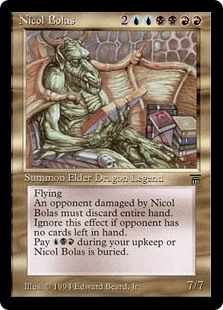
In June 1994, the third set of Magic: The Gathering was released. That set was called Legends, and introduced the first legendary creatures. These included five legendary Elder Dragons: Arcades Sabboth, Chromium, Nicol Bolas (pictured at left), Palladia-Mors, and Vaevictis Asmadi. By modern standards, these are not very good, but Magic was still in its early days and creatures were generally weaker, so at the time, these cards were absolute monsters.
By 1996, a player named Adam Staley had refined his Highlander deck to include Nicol Bolas at its heart. Eventually, his play group further adjusted the rules with keeping the dragons aside as an extra card which could be cast at any time by their owner. A life total of 40 kept games manageable, and the format was expanded to more than two players, forcing defense and aggression to be balanced across multiple threats. This kept the restrictions and likelihood of seeing unusual cards from Highlander, but with a theme allowing focused creativity within some simple restrictions for narrative. This was the beginning of Elder Dragon Highlander, or EDH.
This casual format quickly became popular thanks to the early days of the internet and widespread adoption as a between-rounds game during tournaments for players and judges alike. As more legendary creatures were printed, more options became available to deck builders, and in 2006, a trio of Pro Tour judges created a website to share the rules and format-specific banned cards. While it no longer included Elder Dragons as a requirement for the deck commander, the name EDH was still a common shorthand name for the format.
Eventually, Magic publisher Wizards of the Coast (WotC) decided to formally support the fan format with the release of the first Commander decks in 2011. This was shortly after I started playing the game, but I didn't buy into the official products. Those first decks were a good foundation to start playing the format, but required a lot of tuning to focus the deck toward a consistent game plan. Each included several Legendary Creatures which could support one of the possible strategies in the deck, so swapping cards in could better customize it to your preferred play style.
2024 saw a shakeup in the community rules committee as people argued over card bans and the end result was WotC taking control over the format rules. This has been hotly debated by the community, but outside of the competitive scene, this is all irrelevant. Rule 0 always applies: discuss any concerns about your deck with your opponents, and have fun.
CHOOSING YOUR COMMANDER
With a small list of exceptions, Commander allows players to use almost any card from throughout the entire history of Magic: The Gathering. People play Commander for many reasons. Some want to build the most broken and aggressive deck possible within the restrictions of the format to win as quickly as possible with crazy combos. Some people want to build a deck around a favorite creature type or mechanic. And some people do silly things for the sake of being silly, like "chair tribal," where every card depicts some kind of seat, chair, stool, or throne. This diversity of options is one of the reasons EDH/Commander became so popular in the MTG community.
A commander deck consists of exactly 100 cards, and aside from basic lands, there can be only a single copy of each card. Your commander must be a Legendary Creature. The colored mana pips in its casting cost and rules define the card's color identity, which in turn sets the restrictions on the other 99 cards in the deck. No card may include a mana pip outside the commander's color identity.
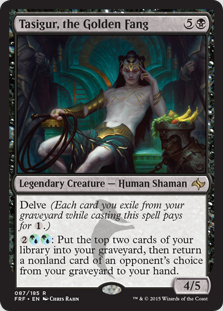
For example, Tasigur, the Golden Fang (pictured at right) has a converted mana cost of 6, because the top right shows 5 generic mana of any color plus one mandatory black mana. However, his ability also includes hybrid green/blue mana symbols which can be paid with either of those two colors. As such, while this card is considered a black creature due to its casting cost, its color identity is black, green, and blue for purposes of EDH.
If chosen as a commander, all three of those colors may be in the casting costs and abilities of cards in the 99, but white and red cards and ability costs are strictly forbidden.
When building a deck with another commander and considering this card in the 99, that commander must also include black, green, and blue in its identity. Tasigur cannot be played in the 99 of a mono-black deck even though he could be cast with just black mana. He also cannot be played in a strictly black/blue or black/green deck even though his ability could be activated with just one of the two colors in the hybrid mana pips.
Whatever you choose, your commander is set aside at the start of the game and effectively functions as an 8th card in addition to the seven in your starting hand. If you commander is killed in combat, destroyed by a spell, or even exiled from the game, it can be returned to this command zone and cast again with a cumulative 2 generic mana added cost.
Here is the first major decision for a Commander: are you choosing it to gain access to cards from specific colors, with the commander as a secondary bonus, or are you choosing your commander to be the key piece of how your deck works and planning to play it as soon as possible to get the most benefit? There are pros and cons to both strategies. Having a commander as a key part of your deck's theme and strategy can help win, but if your commander is destroyed, it's a significant setback even though you can cast it again if you have the mana, and absolutely devastating if you do not.
My mono-red Krenko, Mob Boss goblin tribal deck is not particularly dangerous without Krenko on the table to multiply my goblin count exponentially. However, I have a combination of other cards which support the goblin theme and artifacts I can use to protect Krenko to add some resilience.
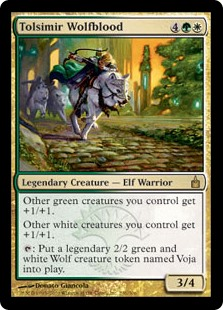
Alternatively, Tolsimir Wolfblood is more of a support commander than a linchpin. A green/white deck usually includes a combination of small horde creatures and big monsters which present a major threat on their own, so adding Tolsimir to the table provides a significant boost, but is not absolutely essential to the deck strategy. In fact, his passive boost is just enough of a threat that he may bait out removal spells which could otherwise threaten other creatures on your board.
Way back when I was a beginner EDH deckbuilder, Tolsimir was one of the first (maybe the first) commanders I tried. I took that deck apart ages ago, but I am thinking about building it anew with a few "secret commander" legendary creatures in the 99 as well. As noted in my Bear Necessities post, Selesnya is known for token hordes, and doubling the power of 1/1 green or white token creatures is powerful.
NEW COMPLICATIONS
EDH started with just 5 Elder Dragons as possible generals. As the format developed, almost all Legendary Creatures were allowed. In recent years as WotC became more involved in publishing cards designed for the format, newer options have also been added to further complicate the choices available to deck builders.
Fundamentally, most of these newer options are variations on the Partner mechanic, which launched with the Commander 2016 sets. This is a mix-and-match rule which allows any two Legendary Creatures to share the command zone if they both have the Partner rule in their text boxes. This has led to some completely broken pairings which competitive players exploit to devastating effect, but it can also mean just a fun theme. Salubrious Snail has a video from May of 2024 about how he built a strong deck with two such cards, and I recommend his channel for deckbuilding tips in general.
The Partner mechanic has been toned down with a few variations. I already mentioned my Wilson, Refined Grizzly deck which uses a Background enchantment as a "partner" card in the command zone. There are also specific card pairings using "Partners With" to create a specific command zone archetype. The crossover cards for Stranger Things and their non-branded MTG-flavored counterparts include Friends Forever, a partner rule specifically for other Friends Forever cards with limited mix-and-match, too.
Finally, there are a few Planeswalker cards which specifically state they can be used as commanders. Normally, although planeswakers are legendary cards, their status as non-creatures excludes them outside of casual Rule 0 group decision to allow them. I own a pair of Planeswalkers with both this special exemption rule and Partner, although I haven't built a deck around them yet.
Remember that any of these new ideas add new possibilities for deck design, but I suggest sticking with a single Legendary Creature for your first deck, and using that as a learning experience to grow as both a player and deck builder. Save the extra complication for later, and just be aware you may run into unexpected things like partner commanders and backgrounds. That is part of the fun of EDH, after all: seeing new and unexpected things!
ON TO THE 99!
Even with the basic color identity constraints of any commander or partner pairing, there are thousands of possible cards for your deck, and remember to allocate about 40 slots for lands, so you really have only about 60 slots for creatures, instants, sorceries, enchantments, artifacts, and planeswalkers. Suddenly singleton feels downright restrictive.
What is the main goal of your deck? Do you need creatures to attack, spells to create powerful combos or chains of storm effects, enchantments to control the battlefield, or some more niche win condition? That's the obvious starting point, but don't forget that you're playing with other people. Interaction is key to a well-rounded deck, so you need ways to ramp mana, remove threats, counter spells that may disrupt your plan, and recover from setbacks. You'll also ideally be talking with the other players, assessing threats, making alliances, stabbing people in the back, and being betrayed yourself.
They best way to build a good deck is to build a mediocre deck, or even bad deck, and learn from the process. I don't claim to be a good deck builder, but I learned far more from trying lots of ideas and seeing what I enjoyed than I ever could from just buying someone else's deck list online and diving in. If you do want more advice, I suggest the Salubrious Snail channel mentioned above and The Trinket Mage, linked below.
You don't need a big budget to cover your bases, and don't worry too much about big budget decks you see online. If you already collect Magic cards, you probably have everything you need to build a functional deck. Then, after playing a few games, you can see which cards worked and which didn't fit. You may see others play cards you want to add, or encounter something you need better tools to defeat. The goal is to play the game, not pay to win, so don't worry about getting the perfect deck plus the perfect starting hand. Shuffle up and play!
